| Sculpture | 646 |
||
| Engravings | 672 |
||
| Ornamentation of Dress | 678 |
||
| Technique of Ornamentation | 679 |
||
XI. — ART.1
The art of the Koryak — expressed in carving, engraving on bone and wood, drawing, and ornamentation of implements — is similar in many espects to the primitive art of ancient man of that epoch of the stone age of southern Europe which is called by the French archaeologists "époque magdalénienne." 2 The climatic conditions and the surroundings of the life of man at that period were, according to geological, palaeontological, and archaeological data, much like those of the life of the primitive peoples of to-day in the polar and near-by regions of the Old and New Worlds.
The resemblance between the graphic art of the Eskimo and that found in the archaeologic remains of the cave-dwellers of southern Europe has led some European archaeologists to formulate the theory of the origin of the Eskimo from the cave-dwellers of France,3 — a theory which is far from being well founded. However, the art of the modern Koryak, as regards sculptural carving and dress-ornamentation, is above the art, not only of the cave- dwellers of Europe, but also of the modern Eskimo.
Sculpture. — For carving, the Koryak employ different kinds of wood, the antler of reindeer and the horn of mountain-sheep, bone of whale, teeth of the white whale and the bear, walrus-tusks, and mammoth-ivory. Sometimes the horn of the narwhal, brought from the shores of the Arctic Ocean, is also used. The material most suitable, on account of its solidity and fineness of grain, is ivory of the walrus and mammoth, especially the latter, which is as hard as the former.4
Both the walrus and the mammoth tusk, before being carved, are put for some time into boiling water, which makes them softer for a while. Walrus-tusk is used to a greater extent than is the mammoth-tusk, because this latter is not found so frequently in the Koryak territory as in the more
1 The manuscript for this chapter
was prepared by Mr. Jochelson while in Europe, and consequently he has
not been able to consult the specimens in his collection. For this reason
some matters of detail have been added
by the editor, and also the greater part of the discussion relating to
the technique and rhythmic arrangement of the
designs on clothing, basketry, and rugs. — Ed.
2 See G. et A. de-Mortillet, Le Préhistorique (Paris, 1900), p. 241.
3
See
Hoffman, p. 764.
4
Mammoth-tusks,
which are obtained as the result of occasional palasontological finds, furnish
good material
for carving if extracted directly from the frozen ground.
Tusks so obtained usually have no cracks, are solid inside,
clean and white, and not much inferior in quality to ivory.
If, however, previous to being found, the tusk has been
washed out of the ground and exposed to the air for any length of time,
undergoing the process of weathering, it
loses its consistency, begins to crack, and assumes a yellow color
resembling that of tobacco-juice.
Concentric layers
are formed
on the
outside, which
gradually separate
from the
rest of the mass, and crumble, making it unfit for
carving-purposes. Articles
made of walrus-tusk also lose their original whiteness when exposed to moisture
for a long
time. Old
carvings from walrus-tusk, both of the Koryak and of the Eskimo, also acquire
the yellow tobacco-color.
[646]
647
JOCHELSON, THE KORYAK.
northern regions of the Chukchee territory,— in the tundra along the shores and on the islands of the Arctic Ocean.
The shoulder-blades and vertebrae of the whale are also used for carving. Not being hard, this bone is well adapted for the purpose; but the coarseness of its grain and its dirty-gray color give to the articles made from it an unattractive appearance. The antlers of reindeer and the horns of mountain-sheep also furnish good material for carving. They are inferior in fineness of grain to ivory. They are sufficiently smooth, and consist of a uniformly hard and tough but not fibrous mass, so that they can be carved and rubbed in all directions. Before being worked, they also are softened in boiling water. Owing to their dark color, however, they do not furnish a material satisfactory to the aesthetic taste of the primitive sculptor, and are used only in the absence of the white walrus or mammoth ivory.
Miniature toy figures of human beings, birds, and other animals, or spoons ornamented with different figures, are frequently made from reindeer-antler and sheep-horn. It is worth noting, that, according to Hoffman, quite a number of specimens of Eskimo workmanship, upon which both simple forms of ornamentation and pictographic records occur, consist of pieces of reindeer- antler shaped into the desired form, and obtained from the barren-ground or woodland caribou; but no specimens of horn of the mountain-sheep or moun- tain-goat, which are employed by the more southern Coast tribes, have as yet been found in the Eskimo collections of either the United States National Museum or the Alaska Commercial Company in San Francisco, Cal.1 Nor are any cases on record of sculptural carvings of animals made of reindeer- antler by Eskimo. Carvings in musk-ox horn are known, however, from the Eskimo tribes of the west coast of Hudson Bay.
Wood as material for carving is employed principally by the Koryak of Penshina Bay, since they do not hunt walrus; but along the shores of Bering Sea, wood-carvings are seldom found, owing to the absence of wood in that region. Nor do we find many small wood-carvings of animals among the Eskimo. The Koryak employ for carving all kinds of wood found in their territory, such as larch, poplar, alder, birch, and stone-pine. As a rule, wood, owing to its fibrous quality and the lack of uniform density in its different layers, cannot be considered good material for sculptural work; and the impracticability of its use is further increased by the primitive instrumentsemployed. The most suitable material, on account of its density, is furnished by the birch-tree and by the roots of the stone-pine; but the latter are so hard that they can be worked only with great difficulty by means of the knife.
Stone is not used by the Koryak as a material for sculptural purposes.
1 See Hoffman, p. 777.
82—JESUP NORTH PACIFIC EXPED., VOL. VI, PART 2.
648
JOCHELSON, THE KORYAK.
This may probably be explained by the fact that the Koryak practised the art of polishing stone very little. As is well known, but few traces of the working of stone for artistic purposes have been found in palaeolithic stations of Europe. Among the Eskimo carvings in the National Museum at Washing- ton, we find some specimens of animal figures made from soapstone and flint.1
Nor do the Koryak use clay for moulding figures, and we do not know if they ever used it for that purpose. In the excavations of ancient dwellings of the Maritime Koryak, mentioned before, I found traces of their former art in pottery which disappeared with the introduction of metallic utensils; but no remains of clay toys have been found.2
There is no doubt that among the works of art of North America, the Eskimo carvings of animals resemble those of the Koryak most closely. The Eskimo, the Koryak, the Kerek, and the Chukchee are the only primitive tribes among whom miniature sculpture has been so strongly developed.3
All the tribes mentioned here use the same technical processes in carving. Their carvings are realistic in character, are of small or even miniature size, and to a great extent are made as much for the pleasure which the carvers derive from their work as for the satisfaction of the aesthetic tastes of the people. The difference between the Eskimo and Koryak carvings is, that the latter are less available for practical application than the former, and are of greater artistic worth. In that regard the Chukchee carvings resemblemore closely those of the Eskimo, judging from the collection furnished by ourExpedition and from the collection of the Ethnographical Museum of the Imperial Academy of Sciences in St. Petersburg.4 Even the Kerek carvings are inferior to those of the Koryak in their finishing touches. The Chukchee and the Kerek carvings still further resemble those of the Eskimo, in that they are more frequently decorated with engravings, consisting chiefly of dotsand lines, than those of the Koryak.
The plastic art of the Indians of the North Pacific coast, in so far as it is expressed in carving, is entirely different from that of the Koryak and
1 See Murdoch, pp. 398, 399.
2 Nelson
obtained on the Lower Yukon, where the art of pottery was formerly developed, a
pair of rudely
modelled clay dolls (see Nelson, Fig. 126 on p. 342, and p. 343). In the
excavations of the ancient Ainu under-
ground dwellings were found, among the remnants of pottery, clay figures
of men. Some figures collected by
Professor E. Baelz are now in the Museum für Völkerkunde of Berlin (see
p. 645). It is possible that the Koryak
made figures of unbaked clay, and that therefore no trace is left of them,
as articles made of unbaked clay crumble
in the moist ground. The avidity with which the Koryak seize upon every material
fit for sculpture may be judged
from the fact that their children, as soon as they convinced themselves
that the plaster I used could be cut with
the knife, started to make toy dishes and animal figures from the pieces which
fell on the ground while I was
making my masks. Before trying the use of the knife, however, they
touched the plaster with their tongues, to see
if they could make more palatable use of it.
Among
European nations, the Swiss are known for their miniature sculpture from wood
and ivory. Really
artistic articles may be found quite frequently among the Swiss products; but as
a rule, their figures of animals,
notwithstanding the careful and detailed finish, produce a less vivid
impression than some of the crude figures of
the Koryak, in which the most
characteristic posture of the animal is brought out.
4 See Bogoras, Chukchee Material Life, Plates XX, XXI.
649
JOCHELSON, THE KORYAK.
Chukchee. Although some samples of Indian art among the collections of the Amerian Museum of Natural History are proof of the ability of Indian artists to give their carvings quite a realistic and artistic expression of animal forms,1 yet the general tendency of the Indian art of carving is purely sym- bolic, aiming principally at bringing out the most characteristic parts of the body of the animal at the expense of its other parts, and of a realistic pres- entation of the animal as a whole.
The carvings of the western neighbors of the Koryak, the Tungus and the Yakut, can in no wise be compared with their own. The former lack all artistic merit. Taking as a fair sample the collection of Yakut carvings obtained by me, consisting of figures of animals or human beings made from mammoth-tusks, we find it to consist of rigid figures having only an outward resemblance to men and animals. The artist was unable to put life and motion into them. It is seldom that any of the Yakut can carve even such crude figures. Near Yakutsk, for instance, two or three Yakut are known to turn out open-work from mammoth-ivory. They also turn out rigid realistic carvings of the kind I am describing. They make combs and boxes from mammoth-ivory, ornamented with open-work carving. Yet these articles are rather products of mechanical art, made to meet the demand of the Russians, than works of art for art's sake.
The art of the Yakut, principally their decorative art, is of purely Central Asiatic, Chinese, or Russian origin, and consists of curves, spirals, and con- ventionalized animals and plants. Only the enormous wooden kumiss goblets and cups, from which the Yakut drink, and make sacrificial libations during the religious kumiss festivals, are supplied with primitive technical ornamen- tation, judging by the Yakut names of the carved figures.2
When we speak of Koryak or Chukchee carvings, it should be added that we refer to the Maritime people only. The Reindeer Koryak, with very few exceptions, have not developed that art. This is not due to the fact that the reindeer-breeders have no aesthetic tastes, but to their lack of the necessary leisure. The Maritime Koryak, on the contrary, spend the winter almost idly in a more or less warm house, and have sufficient time to indulge in the pleasure derived from the art of carving. The same reason may be advanced to explain why only the men engage in carving: the women are too busy with the household, and apply their aesthetic taste to the ornamen- tation of their dresses.
It is worth noting, that, among the Koryak carvings, we seldom find figures of reindeer, and the few we do find are poorly executed. The con- clusion might be drawn from this, that fondness for carving developed among
1
See Boas, Decorative Art of
the Indians of the North Pacific Coast (Bull. Am. Mus. Nat. Hist., IX, p. 125).
2
See
Jochelson, Kumiss Festivals of the
Yakut and the
Decoration of Kumiss
Vessels (Boas Anniversary
Volume, New-York, Stechert, 1906, pp. 257-271).
650
JOCHELSON, THE KORYAK.
the Koryak before the beginning of reindeer-breeding, and that through force of habit the artists used for their models principally objects of maritime life.
The carvings of the Maritime Koryak along the shores of Bering Sea - the Alutor people and those on the rivers Opuka and Poqac — are more artistic than those of the inhabitants on the shores of Penshina Bay. The latter, moreover, lack such material as walrus-tusks, since walrus are not found in their home; and the artists there have to be content mainly with wood, and have to obtain their walrus-ivory through barter.
Among the objects of Koryak miniature sculpture are not only quadrupeds, birds, fish, and other animals, but also human beings. The artists render the figures of human beings or of animals in the round or in relief, mostly in high-relief mounted on a base.
Carvings representing Men. — In carvings representing men, wrestling-matches or the beating of drums, as well as hunting-scenes, are most frequently selected, on account of the animated motions of these actions. In wrestling, as well as in domestic shamanism or in the beating of drums for their own pleasure, men strip to the belt. This is the form in which the artist strives to present vividly the human body. Female figures are carved less frequently,
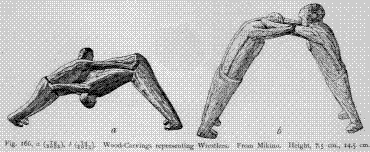
Fig.
166. Wood-Garvings representing Wrestlers. From Mikimo. Height, 7.5 cm., 14.5 cm.
and always dressed. Unlike the Chukchee women, the Koryak women do not strip at home. Besides, the realistic presentation of the female body is much more difficult than that of the male, and it is also more difficult to put life into the figure of a human being clothed than into a nude figure. The striving of the Koryak artists toward the realistic presentation of the human form pertains mainly to the upper part of the body. The curves of the back and the tension of the muscles are very strikingly reproduced in ivory by good artists. The Koryak artist does not take the trouble to finish off in detail the feet of men or of animals. Human heads are more poorly finished than are those of animals.
Let us begin with the less artistic models from the shores of Penshina Bay.
65 I
JOCHELSON, THE KORYAK.
Figs. 166 and 167 represent different forms of wrestling of two contestants. In Fig. 166 two wrestlers are trying to throw each other. In both of these groups some care is bestowed upon the modelling of the back, the muscles of the shoulders and the curvature of the spine being indicated. In Fig. 166, b, an attempt is also made to model the chest. This specimen is not quite complete, the two arms on the farther side beingcarved out, but still con- nected by a piece of wood, which on the nearer side has been whittled away. The farther arms of the wrestlers are so placed that the man on the left rests his straight left arm against the right shoulder of the man on the right; while the man on the right grasps the arm of the man on the left, from above, on the inner side of the elbow. The chests of the wrestlers shown in Fig. 166, a, are not modelled in detail.
Fig. 167 represents wrestlers pulling each other. In these figures neither back nor chest is modelled so as to bring out muscular details. In a the
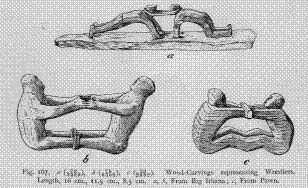
Fig.
167. Wood-Carvings representing Wrestlers. Length, 16 cm., 11.5 cm., a,b.
From Big Itkana; c, From Paren.
contestants, with a leather noose thrown around their heads, are pulling it in opposite directions with the backs of their heads. In b the contestants, sitting on the ground with the soles of their feet firmly pressed against each other's, pull with the hands. In c the contestants, also sitting on the ground, are holding a stick, which each is pulling in his own direction.
Fig. 168 represents a man beating a drum. His position is very char-acteristic. The back and the left shoulder are well modelled, the head being forward and turned to the left. The modelling of the twist of the neck, brought about by this turn of the head, is particularly well executed.
All the carvings in Figs. 166-168 are made from different kinds of wood. In spite of the crudeness of the work, the absence of detail, and the lack of proportion in the parts of the bodies, the figures reveal the attempts
652
JOCHELSON, THE KORYAK.
of the artist to make the position and the curves of the body correspond with the movements expressed in the figure.
Figs. 169 and 170 represent carvings from walrus-ivory. With the exception of Fig. 170, a, made at Opuka, all the other figures were carved in Paren and Kuel. The details of these carvings alone put them above the wood-carvings of the same villages. To a considerable extent this feature depends on the quality of the material; but, aside from that, the carvers of
|
|
these figures were the best masters of the art to be found on the shores of Penshina Bay. The idea of representing people in motion — singing, dancing, and beating the drum in different fantastic postures — must be called bold for a primitive sculptor. The Koryak sculptor has no model to copy from. In his creative art he must reproduce from memory exclusively, without the aid of the accessories of modern |
| Fig. 168. Wood- Carving representing Drummer. From Mikino. Height, 10.5 cm. | |
artists, the real forms impressed upon his mind. As yet he is unable to reproduce the details, or to finish the parts of the body in the carved figures, true to nature. The figures themselves represent a more or less vague sketch of the artist's idea. All the little figures of dancing shamans in Figs. 169 and 170 resemble very much the unfinished work of a modern sculptor, in which the posture is well defined, the proportion of the parts is preserved, and a certain animation is to be seen. As little finished as are the faces of the dancing shamans, one can read the expression of ecstasy in some of them, as in Fig. 169, b and d. In all these specimens the muscles of the back and the neck are much better modelled than those of the chest and of the limbs. In most of them the details on the limbs are entirely wanting. In the specimen shown in Fig. 169, d, an attempt is made to model the chest too. On all the drums the cross-strings forming the handle are indicated on the inner side. On some of them the cords are undercut, so that they are similar to the cords made of nettle-threads, of the actual drums, although thicker. In others they are simply indicated by bars extending across the drum, which are not separated from the flat surface indicating the inner side of the drum-head. In all these specimens the drum and the drum-stick are connected by sinew or skin string. The iron rattles on the drum 1 are not indicated.
1 See Part I, Fig. 19, p. 55.
653
JOCHELSON, THE KORYAK.
It should be noted that most of the carvings in Figs. 169 and 170 are made without mountings; and, in order to give them stability, the artist had to guess at the position of the centre of gravity. The drum, which is heavy as compared with the figure of the man, is designed to shift the centre of gravity to the fore part of the figure. All the drums held by the men in Fig. 169 and in Fig. 170 b, and the drum-sticks belonging to them, are carved
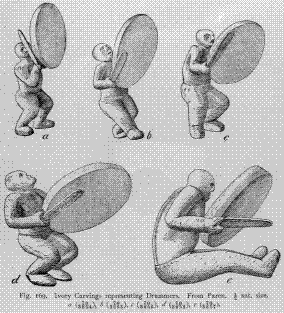
Fig.
169. Ivory Carvings representing Drummers. From Paren. 1/2 nat. size.
separately from the human figure, and inserted in notches in the hands, the fingers being left entirely unfinished. On the contrary, the carving shown in Fig. 170, a, representing a dancer with a drum and a drum-stick, is wrought from one piece of walrus-tusk, including the base. This figure was made on the river Opuka. Its extremities are finished better than those in the pre- ceding figures, and the hands have carved fingers as well. The drum-stick is too large as compared with the drum; but this license was taken to give support to the drum. It should be noted that not all the figures show the upper edge of the trousers, although it is supposed that the men are stripped only to the belt.
654
JOCHELSON, THE KORYAK.
The carvings represented in Fig. 170 differ from the preceding in that more care is bestowed on the representation of the head. While all the preceding figures have no hair and no ears, we find here the characteristic hair-dress of the Koryak shown. The middle of the head is shaved, and
|
the ring
of hair is indicated by an ivory ring with
hachure.
In Fig. 170, b, the ears are also repre-
sented.
While in the first of these two specimens the
lively motion and the characteristic pose of the
head
deserve particular
praise, as
also the attempt to
represent the hand hold-ing
the drum and the rattles attached
to the drum, the figure
shown in b is very disproportionate.
It is, how- ever,
the only one of this group
in which the muscles of
the arm are represented with
any detail. The left profile
of the man is par- ticularly
good. On the left side
the folds in the skin of
abdomen and
chest,
|
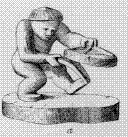 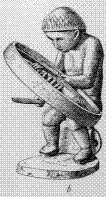 |
| Fig. 170. Ivory Carvings representing Drummers, Height, 5 cm., 12 cm. a From Opuka River; b, From Kuel |
brought about by the forward inclination of the body, are also represented emarkably well. On the drum all the attachments are represented in detail.
Fig. 171 shows two men producing fire with the bow-drill. The
|
|
execution of these figures is similar to that of the figures shown in Fig. 169.
A
still higher technique and greater
artistic merit are to be found in
the figure of a man on a base, holding
a drum, which was obtainedby
Mr. Bogoras on the shore of Bering
Sea (Fig. 172,a). It is carved from
walrus-tusk. The plastic curves of
the back and the tense muscles of
back and sides are rendered withanatomical
accuracy and realistic vividness.
The chest is flat, and the
muscles are not indicated.
This
|
| Fig. 171. Ivory Group representing the Drilling of Fire. From Paren. Height, 7 cm. |
may be due to the difficulty of reaching the chest. The surface of the chest is rough, while the whole rest of the figure has a high polish. The head is executed in great detail; and the cut of the eyes, and the form of the cheek-
655
JOCHELSON, THE KORYAK.
bones, are quite characteristic of the Siberian type. The same vivacity, though less artistic execution, marks Fig. 172, b, which represents a man who has caught by the antlers a young reindeer which is trying to pull back. In Fig. 172, a and b, the heads of the human figures are represented as having the hair cut in a circle, and tonsured in the middle

Fig. 172. Ivory Carvings. a Drummer (height, 6 cm.); b, Man and Reindeer (height, 4.5 cm.).
Fig. 173, a human figure in sitting posture, made from wood in the settlement of Big Itkana, represents the captain of an American whaling- schooner who goes to Penshina Bay nearly every summer. The figure is painted black. This figure is marked by the absence of any artistic merit like the other wood-carvings of the Koryak of Penshina Bay; but it is inter- esting to note that the figure is given a droll aspect with the hat pulled over
| the eyes, the buttoned-up coat, and the hands thrust into the pockets. Similarly we find in the Chukchee collections of carvings of the Ethnographical Museum of the Imperial Acad- emy of Sciences in St. Petersburg a human figure — judging by the cap, an American or Russian, — in a comic and rather indecent posture.1 |
|
| Fig. 173. Wood-Carving representing Captain of a Whaling-Vessel, From Itkana. Height, 9 cm. |
Among the walrus-tusk carvings from the shores of Bering Sea, representing human beings, we found also specimens without any artistic value, as is shown by Fig. 174, a, b. These two crude carvings, — with arms indicated, but not separated from the rest of the body, — although obtained by me in the settlement of Kuel (Penshina Bay), had their origin on the Opuka River (Bering Sea).
Fig. 174, a, represents a woman in a sitting position, with a child on her lap. The hole in the lower part of the figure shows that it is intended
1
See Bogoras, Chukchee Material Life, Plate XXI,
Fig. 12.
83—jesup
north pacific exped., vol. vi, part 2.
656
JOCHELSON, THE KORYAK.
to be carried on a strap, and to serve as a toy, not as a specimen of real art This explains why the figure has no finish. The face of this figure is perfectly flat.1 Fig. 174, b, also appears to represent a woman. The occur- rence of engraved and etched concentric and single circles, dots, and lines, which are common ornaments on the animals carved from ivory by the western Eskimo, are to be noted on this figure, and also the suggestion of an Eskimo woman's jacket, with its characteristic hood and front flap. On the back the row of circles with dots is continued by two more circles on each side, leaving the middle of the back, just over the legs, undecorated.
|
|
Over this row is another horizontal row of five circles with dots, which extend over the back from arm to arm. The collar-like shoulder-part is continued over the back with a slight curve downward. The spacebetween the double line, which is continued from the front over the shoulders, and the sharp lower edge of the garment, is occu-pied by a line of seven black dots which slant a little upward from left to right. On the middle of the hood at the back are two circles with dots, — one over theother, — and a number of vertical lines of dots which curve forward at their lower ends. This figure probably represents an Eskimo woman, or it may have been made by an Eskimo artist. |
|
Fig. 174. Ivory Carvings. a, Woman and Child (height, 2.5 cm.); b, Woman in Fur Dress (height, 6.5 cm.). |
In connection with the various Koryak carvings, the wooden figures of men should be mentioned, made without any artistic finish, with their extrem- ities on pivots, like mechanical dolls. These figures serve as toys for children, and are to be found also among the Chukchee.2
At a previous place I called attention to the crudeness of the images and the conventionality of the figures of idols and amulets.3 Compared with the carvings of the Koryak of the coast of Bering Sea, the images of their anthropomorphic "guardians" appear like the products of a backward tribe.4 In connection with this question, I advance the hypothesis that the cause of the crudeness of religious carvings lies in the vague conception of the artist as to the appearance of the invisible anthropomorphic beings. Between the
1 Compare Part I, Fig. 56, p. 114.
2 See Bogoras, Chukchee Material Life, Plate XXI, Fig. 7.
3 See Part I, p. 115.
4
In a note published in C. Lumholtz's Decorative Art of the Huichol Indians,
Professor Boas discusses the
crudeness of amulets and other sacred objects, as compared to the
elaborate finish of objects of art. He calls atten-
tion to this phenomenon among the Huichol Indians, the Gold, the Gilyak, and
other tribes (see Memoirs of the
American Museum of Natural History, Vol. III, p. 287).
657
JOCHELSON, THE KORYAK.
two classes of carvings, the religious and the realistic, there are, of course, intermediate stages, especially in carvings that serve practical purposes; but, in so far as realistic sculpture aims to afford pleasure, it has a development independent of religion : its only source is in the aesthetic need of man.
Of course, all our wants, both material and spiritual, influence each other to a certain extent. So religious ideas have almost always influenced the character of art, and the influence has generally been detrimental.1 I even go so far as to think that the symbolic tendency in the plastic art of the Indians of the North Pacific coast is also due, to a certain extent, to religious ideas. The symbolism of these Indians in sculpture is a perversion of true realistic art. The high technique displayed by Indian artists in their carvings of masks, helmets, and other articles, clearly proves that realistic represen- tations of animals are not beyond their power.2
Professor Boas explains the symbolic tendency of the Northwestern Indians by the dependence of the art of sculpture on the material, — that is, that, since it serves for decorative purposes, the subject to be represented is more or less subordinate to the object on which it is shown,3 — but it is quite possible that the symbolism of the carvings made in connection with totem- posts was due to a vague conception, on the part of the artists, of the totem ancestors, whom they imagined now as real animals, and now in anthropo-morphic form. The only features which are essential, therefore, for the recognition of the ancestor, are those that are most characteristic of his animal state, at the expense of the secondary features. The application to the human face, of the characteristic features of the head of the animal which serves as a totem, may be explained in the same way.
Carvings representing Animals. — In the archaeologic remains of the stone age of the Old and New Worlds we find, among works of primitive art, representations mainly of human figures, and very few of animals. In the miniature sculpture of the Eskimo, principally made of ivory, we see, on the contrary, a tendency to reproduce mostly animal forms; but in the Chuk- chee and Koryak carvings we find, side by side with animal forms, also those of human beings.
Carvings of human beings have been described in the preceding pages. I shall now take up specimens of carvings of animals. Here I must repeat what I have already said, that the carvings of animals among the Koryak and Chukchee are much less frequently adapted to definite purposes than they
1
Taking our
illustrations from the
history of the
sculpture of civilized nations, we
see, that, among the
Greeks, religious
ideas corresponded
with the
requirements of
realistic art;
Buddhism, and
to a certain extent
Christianity, introduced a great deal of
conventionalism into sculpture; while the Semitic religion entirely suppressed
this branch of art.
2
See
Boas, The Decorative Art of the Indians of the North Pacific Coast (Bulletin of
the American Museum
of Natural History, 1897, Vol. IX, p.
124).
3
Ibid.,
pp. 123—176.
658
JOCHELSON, THE KORYAK.
are among the Eskimo. Among the Koryak, as well as among the Chukchee, real artistic carvings of animals have for their object solely the satisfaction of the artistic taste. I had opportunities to see how carvings brought to the settlements along Penshina Bay from the shores of Bering Sea were preserved in the work-bags of the women, who would frequently take them out only to look at them. To what extent the artistic instinct is developed among the Koryak may be judged from the fact that they easily recognized drawings and pictures in the books which I showed them, and always recognized the photographs of their friends. On the contrary, the northern Yakut, the Tungus, and even the Yukaghir, frequently failed to recognize photographs
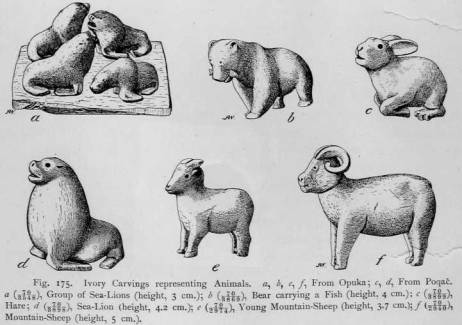
which I took of their friends. Some of them even failed to recognize that the photographs represented human faces.
Specimens of Koryak carvings representing animals are shown here in Figs. 175 -179. Those represented in Fig. 175 were obtained by me among the Maritime Koryak on Penshina Bay, but were made originally by the in- habitants of the coast of Bering Sea. All are carvings from walrus-tusk. That shown in a represents a group of four sea-lions (Enmetopias Stellen Peters) on an ice-floe; b, a black bear (Ursus arctos L.) with a fish in its mouth; c, a white hare (Lepus variabilis Pall.) in a sitting posture; d, a sea-lion (Eumetopias Stelleri); e, a mountain-lamb; and f, a mountain-sheep (Ovis nivìcola Eschholtz).
As I said before, in speaking of Koryak carvings in general, the feet of
659
JOCHELSON, THE KORYAK.
the animals are imperfectly made, although these carvings represent the work of the best artists. It should be said, however, that the unmounted animal carvings could not stand if the feet were made properly. To give them greater stability, the feet of the two sheep (e, f) are not entirely separated. On the other hand, the flippers of the sea-lions on the ice-floe, which serves as a stand (a), are finished very vividly as compared with those of the single sea-lion without stand (d). On the whole, however, the position and the motion of the animals of the carvings are rendered with such realism as to call forth vividly its picture in the mind of the spectator, and they testify to the great skill and aesthetic taste of the artist.
In comparison with these specimens, the carvings of Chukchee artists are of far inferior artistic merit.1 Even more inferior than these specimens are the Eskimo carvings of animals made at different places, and obtained by different collectors, although the nature of the Eskimo carvings, and the method of working them, are exactly the same as those of the Chukchee and Koryak.2
Among the Koryak carvings we do not find, for reasons which are perfectly apparent, any figures of the polar bear; but we do find them among the Chukchee ;3 and it is remarkable that the Chukchee carvings of this animal, judging from the specimens reproduced by Bogoras, are distinguished by thesame artistic faults as those made by the Eskimo. Without explicit descrip- tion, it is difficult to recognize the polar bear in the Eskimo carvings intended to represent that animal.
The walrus and seal are very vividly reproduced in Koryak carvings; but the figures of whales are lifeless, and resemble very much the Eskimo carvings of whales (compare, for instance, the wooden whale in Part I, Fig.. 30, a, p. 72, with the Eskimo figures of whales).4 However, the whale reproduced on p. 72 is made for a religious ceremony; and carvings made for religious purposes are, as I have said, inferior to those made for aesthetic purposes. This becomes especially clear when comparing, for instance, the realistic figure of a bear in the carving in Fig. 175, à, with the crude wooden bear made for a festival on the occasion of a bear-hunt.5 Artistic carvings are produced only by men endowed with special skill and with a leaning towards art, while religious carvings are made by any Koryak.
Fig. 176 represents fishes, a worm, and a grasshopper. Three of these (a, d, and e) are made from walrus-tusk, one (b) from mammoth-ivory, one (c)
1 See Bogoras, Chukchee Material Life, Plates XIX en dash XXI.
2
Compare
Boas, Central Eskimo, Plate IX, opp. p. 653; Baffin-Land Eskimo, p. 113. See
also Murdoch,
The Point Barrow Eskimo, pp. 398-401; Nelson, The Eskimo about Bering
Strait, pp. 345, 346; E. Bessels, Die
amenkanische Nordpol-Expedition, p. 108.
3
See Bogoras, Chukchee Material Life, Plate XX, Fig. 4.
4 See Murdoch, p. 403, Fig. 407; Boas, Central Eskimo,
Plate VIII, opp. p. 652.
5 See Part 1, Fig. 39, p. 88.
660
JOCHELSON, THE KORYAK.
from bone of whale. All of these carvings were made on the shore of Bering Sea. The one shown in d is especially vivid. Fig. 176, a, judging by the fin on the back, near the tail (evidently the adipose fin) represents a fish of the family Salmonoidce, probably Salmo lagocephalus. The fish is ornamented with engraved dots and lines painted black, similar to the etchings of the Eskimo, especially those of Alaska; but they are made with more idea of symmetry. We find similar ornamentations in the carvings of the Kerek and Chukchee. Fig. 176, c, represents a flounder. The tail and the fins are
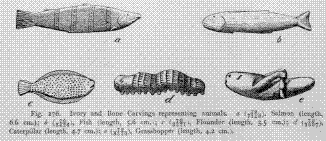
Fig.
176. Ivory and Bone Carvings representing animals. a, Salmon (length, 6.6 cm.);
b Fish ( length, 5.6 cm.); c, Flounder (length, 3.5 cm.); d, Caterpillar (length,
4.7 cm.); e, Grasshopper (length, 4.2 cm.).
indicated by small engraved lines; and the entire body is covered with dots on the front, while on the back the ornamentation consists of a herring-bone pattern running from head to tail. An exactly similar flounder is contained among the Koryak carvings of the Museum of the Academy of Sciences at St. Petersburg, where there is also to be found another specimen without dots.1 A similar figure of a flounder with dots is in the Eskimo collection of E. W. Nelson, made in Alaska.2
Fig. 177 represents carvings of birds. All of them were made near Bering Sea, and a and c are carved from walrus-tusk; b, from mammoth- ivory. Fig. 177, a, represents a sea-bird, probably a cormorant. The neck and head of the bird are life-like, but the wings are not indicated; and there are no feet, the bird being represented as sitting on the water. As a rule, the common way in which the Koryak represent birds in their carvings is to make them appear in a floating or sitting position, so as to avoid the neces- sity of making the feet: another way is to represent them soaring with out- stretched wings. Little figures of birds are carved by children from various materials. Near Penshina Bay they are made from reindeer-antler and moun- tain-sheep horn, also from birch-wood or roots of the stone-pine.
In the Koryak collection of the American Museum of Natural History there are a large number of small carvings of water-birds, birds of prey, and
1 See
Bogoras, Chukchee Material Life, Plate XXII, Figs.
15, 16.
2 See
Hoffman, The Graphic Art of the Eskimo, Plate lvii,
Fig. I.
661
JOCHELSON, THE KORYAK.
others. There are also wooden partridges with well-defined wings. Some of the carvings representing birds are ornamented with black dots, like some Eskimo carvings of birds.1 Turner mentions a collection of carvings of water- birds made from ivory by the Eskimo of Hudson Bay, mainly identical in type with the similar carvings of the Koryak and Chukchee, but not orna- mented with incised designs.2
According to Professor Boas, the Central Eskimo use carvings — some representing birds, others men or women — in a game similar to dice, which
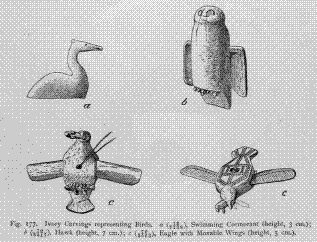
Fig.
177. Ivory Carvings represenying Birds. a, Swimming Cormorant (height, 3 cm.); b,
Hawk (height, 7 cm.); c, Eagle with Movable Wings (height, 5 cm.).
they call "images of birds."3 Murdoch obtained a collection of carvings representing birds and a wolf from the Asiatic Eskimo at Plover Bay. The carvings were supposed to be merely works of art, but Murdoch admits that the Asiatic Eskimo also use them for games.4 Turner, on the other hand, remarks about his collection of ivory carvings representing birds made by the Labrador Eskimo, that he never heard of their being used in games.2 Nor have I ever heard of the Koryak using bird carvings in games.
The nature of the carvings in Fig. 177, b, c, makes them less realistic than the miniature carvings representing birds. The introduction of claws as a substitute for feet seems to me to be the first step in the process of con-
1 See Boas, Central Eskimo, Fig. 522,
p. 567; Nelson, Fig. 125, p
342; Murdoch, Fig. 364, p. 365.
2 See Turner, The Hudson Bay Eskimo, Fig. 83, p. 260.
3 See Boas, The Central Eskimo, Fig. 522, p. 567.
4 See Murdoch, p. 365.
662
JOCHELSON, THE KORYAK.
ventionalization of the plastic art, which developed among the Indians of the North Pacific coast. Moreover, the tail, wings, and body in Fig. 177, b, representing a mouse-hawk, are much inferior in their realism and artistic finish to most of the Koryak carvings. Fig. 177, c, represents an eagle with a fish in its talons, and in the beak a little animal, the hind part of which is broken off. This figure served as a mechanical toy; it has detachable wings, which are made to move by means of a thread. This made it difficult for the artist to observe realism in making his figure. The upper side of the figure is ornamented by etched designs; the wings, by lines indicating feathers; and the back and tail, by dots and squares, — the conventional way of representing the body and tail of a bird.
Fig. 178 represents carvings which differ in material, and were made in different places. The one in a was made in the settlement of Shestakovo
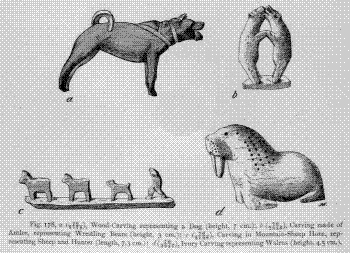
Fig. 178. a, Wood-Carving representing a Dog (height, 7 cm.), b, Carving made of Antler, representing Wrestling Bears (height, 3cm._; c, Carving in Mountains-Sheep Horn, representing Sheep and Hunter (length, 7.3 cm.); d, Ivory Carving representing Walrus (height, 4.5 cm.).
(Penshina Bay), from wood, and the work is well done. The tense posture of the dog in harness, with tail curved upward in expectation of the start, is quite vivid, but the rigid feet are not well executed. The dog is painted black. The carving marked b, a pair of wrestling bears, was made in Paren (Penshina Bay), from reindeer-antler. Wrestling bears are a favorite subject among Koryak artists, but near Bering Sea they are carved from walrus-tusk with greater skill. In our collection there are two bears in the act of coition, made from wood, and carved with great realism. The specimen shown in c was made from mountain-sheep horn, in Kamenskoye (Penshina Bay). On a
663
JOCHELSON, THE KORYAK.
common mounting we have two mountain-sheep pursued by a dog and a man. The latter figure has its head broken off. Its feet display motion, but this cannot be said of the other figures in the group. In d is represented a walrus in sitting position, made at Opuka (Bering Sea), from walrus-tusk. Although the upper part of the body is very realistic, the carvings made from walrus-tusk along Bering Sea are generally more artistic. This specimen is of interest in that it is ornamented with dots in Eskimo fashion. Such ornamentation is very seldom found on the carvings from the coast of Penshina Bay.
Specimens of carvings of animal groups and hunting-scenes have been shown in Fig. 175 a and Fig. 178 c. Figs. 179 and 180 represent specimens of small carvings of more complex groups, which do not serve any practical purpose, and must therefore be classed with art pure and simple. The most interesting feature of these carved groups is the absence of bas-relief. The
|
mounting serves simply as a base for the group, which is carved out of one piece with the former; or the groups form high-re- liefs (Fig. 179, b). However, I have also seen bas-relief carvings in which the figures were raised less than half their height above he base. Among
|
|
| Fig. 179. Ivory and Wood Carvings representing Hunting-Scenes. Length, 14 cm., 20.5 cm. |
these carvings, certain groups represent some household or hunting scene; others, as in Fig. 179, a, a free combination of several scenes having nothing in common. This specimen represents on one side a man aiming his gun at a bear; on the other side, a man getting into a hand-to-hand fight with a bear; and in the middle, a rock with a bird sitting on it. This group is carved from walrus-tusk, and was obtained by me in Paren (Penshina Bay), but was made at Poqa'c (Bering Sea). The high-relief carving shown in b comes from the settlement of Levati (Penshina Bay), and is made from stope- pine. On the right hand is shown a whale pursued by hunters in a skin boat. The edge of the boat was broken off accidentally in working the brittle wood with a knife. The form of the boat, the prow being narrower than the stern, shows that it is of the type of the upper part of Penshina Bay.On the left side is shown a ground-seal (Erignathus barbatus) on an ice-floe, and two hunters stealthily approaching, — one in a skin boat, and the other in a dug-out. The hunters have hunting-hoods on their heads, which make
84—JESUP NORTH PACIFIC EXPED., VOL. VI, PART 2.
664
JOCHELSON, THE KORYAK.
them resemble the heads of seals. The carvings do not show any oars, either n the large' skin boat or in the small boat. The middle of the high-relief carving represents a bear approaching a ringed-seal (Phoca hispida), which was evidently left on the ground by the receding tide.
Fig. 180, a, represents a large skin boat with oarsmen, and is carved from walrus-tusk. It was obtained in the settlement of Big Itkana (Penshina

Fig. 180. Ivory Carvings. a, Boat (length, 8 cm.); b, Walrus and Hunters (length, 9.5 cm.).
Bay). According to the Koryak, it was made in that settlement; but it is very strange that the shape of the boat, the prow being wider than the stern, should resemble the Koryak skin boat of Bering Sea. This is shown by the position of the man at the stern and the four oarsmen sitting with their faces toward the stern. A child is shown sitting in the bottom of the boat, near the stern. Fig. 180, b, is a carving made at Opuka (Bering Sea), from walrus-tusk, and represents an ice-floe with six walrus on it, and two hunters close by, their guns resting on supports and levelled. The seal-skin boat of the hunters, with the broad prow of the Bering Sea type, is also on the ice-floe. Fig. 181 shows a carving of walrus-tusk from Paren (Penshina Bay), and represents a sledge drawn by six dogs, with the driver and his whip, the

Fig.
181. Ivory Carving representing a Dog-Sledge Length,
21.5 cm.
latter serving as a brake. The sledge, dog, harness, and base are all carved from one piece, while the driver and his whip are carved separately. It is interesting to compare the driver of this sledge with an Eskimo figure (made of ivory)1 from Point Barrow, representing a man in sitting position. Both carvings are very much alike.
Fig. 182, carved from walrus-tusk at Paren (Penshina Bay), is a specimen
1 See Murdoch, The Point Barrow Eskimo, Fig. 394, p. 396.
665
JOCHELSON, THE KORYAK.
of architectural carving, and represents a dwelling of the Maritime Koryak before it is covered with earth.1 On the roof is seen a man coming up the ladder through the opening. One of the poles is mounted with the head of a sacrificial dog, and next to it is the spear with which the dog was stabbed. Fig. 183 represents a model of a dog-sledge with a ten-dog team and the driver. This model was made by a Russo-Koryak half-breed by the name
| of
Fletcher. He was
born in the Russianized
Koryak
settlement Yamsk,2
and is now en-
gaged
in trading at Gishiginsk.
He owes
his
American name
to the fact that when his
father or grandfather
was baptized, a Russianized
American who
had settled at Tighil
in Kamchatka acted as his godfather.
The skilfully finished model of the sledge is made of birch-wood; and the dogs, of stone-pine. The way the dog-carvings are finished reveals an artistic talent of high order. The artist has not only put life and motion into the wood-carvings, but has skilfully rendered the different postures of the dogs as determined by the temper |
|
|
Fig. 182. Ivory Carving representing a House. Height, 11 cm. |
of each animal, the phase of its motion, or other factors. Thus the forward pair of dogs are made with tails hanging down. Being the leaders, they are intent upon following the trail pointed out by the driver by shouts,3 to which the dogs are listening. The drooping tails indicate fatigue or intense strain on the part of the dogs. The hindmost pair of dogs are also characteristic. Usually the lazy dogs are put next to the sledge, so that they can be more

easily reached by the whip. One of the dogs in the last pair, fearing the whip, is pulling very conscientiously, as is shown by its lowered head. Th other dog is turning its head on the run towards the driver, to make sure that he is not harboring any evil designs against it.
Of course, this carving cannot be considered as primitive Koryak. Fletcher, being able to read, had seen specimens of art of civilized nations in the
1 For a description of dwellings see pp. 453—461. 2 See p. 436. 3 See p. 505.
666
JOCHELSON, THE KORYAK.
drawings of illustrated magazines, which may have influenced him; but his skill and his native artistic instinct were inherited by him from Koryak ancestors. In explanation of Fig. 183, I should add that the dog-harnesses, central line, and the lashings of the sledge, were made by Fletcher of leather. For the figure of the driver he made a wooden head with a face showing very well the Koryak type. The figure is dressed like other Koryak dolls.
Household Articles ornamented with Carved Figures. — I have stated before that carvings were less frequently of practical use among the Koryak than among the Eskimo. Nevertheless small household articles ornamented with carved figures of men and animals, such as we find among the Eskimo, are also to be found among them. Figs. 184 and 185 are reproductions of such articles.
Fig. 184, a, is a dipper made from alder-wood in the settlement of Big Itkana (Penshina Bay). The handle of the dipper shows a carving representing
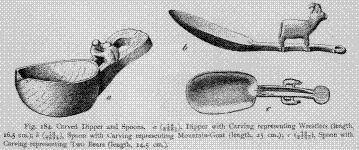
Fig.
184. Carved Dipper and Spoons. a, Dipper with Carving representing Wrestlers (length,
16.5 cm.); b, Spoon with Carving representing Mountain-Goat (length, 25 cm.); c,
Spoon with Carving representing Two Bears (length, 14.5 cm.).
two wrestlers. Only the upper parts.of the bodies are shown. Fig. 184, b, represents a spoon made on the shores of Bering Sea, from the horn of mountain-sheep. Fig. 184, c, was made from mountain-sheep horn in Alutor (Bering Sea). The handle is ornamented with carvings representing two bears.
Among small articles ornamented with carved animals, our collection contains also belt-clasps with the figures of two seals, and a pipe with the figure of a seal, made from walrus-tusk in Kamenskoye (Penshina Bay).
Fig. 185 is also a reproduction of specimens of carvings made for orna-mental purposes. That marked a represents a snow-beater made from antler of wild reindeer by a Reindeer Koryak of the Opuka River, and is orna- mented with a carved head of a mountain-sheep; b represents an awl used by women in ornamenting their dress with slit-embroidery.1 The handle of the awl was carved from wood in Big Itkana (Penshina Bay), and the orna-
1 See p. 679.
667
JOCHELSON, THE KORYAK.
mentation represents a sledge with a team of eight dogs. Apparently the whole handle represents at the same time a bear, the point being the snout, the ears being indicated just under the sledge, and the two prominences on the lower side representing fore and hind feet. It resembles in form the bear figures used by the Eskimo in the cup-and-ball game.1 The specimen shown in c is a pipe made of bone in Kamenskoye (Penshina Bay), and very crudely ornamented with the carving of a human face.
The Koryak carvings of animals on household articles follow the rule
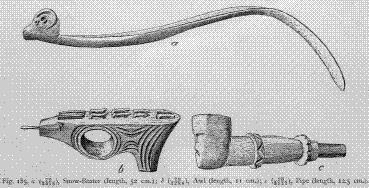
Fig. 185. a, Snow-Beater (length, 52 cm.); b, Awl (length, 11 cm.); c, Pipe (length, 12.5 cm.).
of modern ornamental carvings, — that of serving to embellish and brighten up the ornamented article without obscuring it. For that reason, ornamental carving may retain its realistic character of pure art. Among the Indians of the North Pacific coast we find a tendency to cover the entire article with an ornamental animal. It has been pointed out by Professor Boas2 that this tendency has resulted in depriving carvings of their realism. Judging by some illustrations of objects in the work of Nelson,3 this inclination prevails to a considerable extent also among the Alaskan Eskimo. Professor Boas ascribes this tendency of the Alaskan Eskimo to the influence of the art of the adjacent Indians. Perhaps a trace of this proneness to turn an orna- mental animal into a real article, certainly its inception, is to be found among the Koryak and Eskimo of other localities, but in a most primitive form. Thus the wooden cup for the whale festival among the Koryak4 represents that animal. In the Eskimo collections from Point Barrow we find a bone
1 See Boas, Central Eskimo, p. 566.
2 See Boas,
The Decorative Art of the Indians of the North Pacific Coast (Bulletin of
the American Museum
of Natural History, 1897, Vol. IX, p.
124).
3 See
Nelson, Plates XLII, lxii,
and Figs. 40, 59, pp 144,
200.
4 See Part I, Fig. 30, b, p. 72.
668
JOCHELSON, THE KORYAK.
ladle, and boxes for harpoon-heads, in the form of whales; 1 and among the Eskimo of Hudson Bay we find ivory needle-cases carved in the form of whales.2
I believe that the aesthetic taste is as strong and spontaneous a longing of primitive man as are beliefs. Whoever has lived among primitive people knows well how strong is. their passion for all kinds of ornaments. In one of his stories from the life of the Chukchee, Mr. Bogoras pictures a hunch-back shepherd gathering variegated pebbles, and spending his leisure time in laying them out in different combinations for his own pleasure.3 Mr. Bogoras told me personally that the incident was drawn from real life. Undoubtedly there are cases when an article which first served as an amulet becomes, in the course of time, an ornament; but there are cases, on the other hand, when an article of art becomes an amulet later on. For that reason we must prove in each particular case the course of inter-action of the two psychological factors, — the religious and the aesthetic, — and this it is not always easy to settle. Taking, for instance, the wooden figure of the whale for the whale festival,4 it is difficult to tell whether the whale-carving was first made from a mere desire on the part of the artist to imitate nature, or whether the necessities of the ritual furnished the impetus for carving the whale. Personally I am inclined to the former hypothesis. We find a simi- lar phenomenon in the Eskimo custom of putting the carving of a whale into the mouth of a new-born male infant in order to make him a good hunter.5
In the Koryak carvings, and to a certain extent in those of the Eskimo, in so far as they are not adapted to practical wants, we have an excellent illustration of the spontaneous development of primitive art independent of religion. Those amulets which consist of wooden limbs or parts of animals, instead of the entire animal, cannot be classed with pure art, because they serve, not as expressions of real sense-impressions, but of vague ideas of anthropo- morphism and the substitution of a part for a whole. This accounts for the crudeness of the images of Koryak idols, as pointed out by me before, which distinguishes them from carvings made for the pleasure of carving. Orna- mental carving still retains in many cases the realism and the finesse of art for art's sake; such as, for instance, the mountain-sheep on the spoon illustra- ted in Fig. 184, b.
Less attention is paid to finish and realism in the carving of toys. A large number of objects in miniature carving, used as toys, are very poorly executed. These objects can easily be recognized by the hole made in them, by means of which they can be strung on a thong. Children quite frequently
1 See Murdoch, Fig. 45, p. 105; Fig. 251, p. 249. 2 See Boas, Baffin-Land Eskimo, Fig. 136, p. 93.
3
Tan (nom-de-plume of Mr. Bogoras), Sketches and Stories, Vol. III, Chukchee
Stories (St. Petersburg,
1900), p. 120.
4
See Part I, Fig.
30, a, p. 72.
See Boas, Baffin-Land Eskimo, p.
160; Nelson, p. 290.
669
JOCHELSON, THE KORYAK.
carry whole bunches of such toy carvings so strung. Probably for the same purpose, many Eskimo carvings have holes in them. The workmanship of the walrus-bone carving in Fig. 174, a, representing a woman with a child, may be explained by the fact that it was meant for a toy.
Dolls. — In connection with the carvings which serve as toys, and are made by men, I will speak briefly of the dolls, which are made by women. They differ from carvings which represent human beings, first of all, by the fact that the main attention is paid to the dress of the toy, which is made by the women and girls very carefully and tastefully. In this respect the Koryak dolls are much like those of the Eskimo. Dolls representing women show underneath the coat the wide trousers of the combination-suit tucked into the boots; while the head has braids of hair, wool, or beads, attached on the side or at the back. Fig. 186, a, shows a doll representing a woman
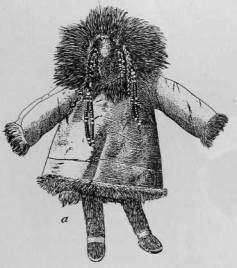
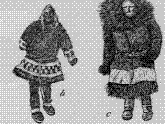
|
with braids, but the long coat conceals the wide trousers of the woman. Fig. 186, b and c, shows two dolls representing Koryak men, — one in a travelling-coat, and the other in a house-coat. No attention is paid to the face in making dolls. In c we find a particularly well carved and typical wooden face; but in b there is, instead of a head, a leather cone in the form of a sugar-loaf, with beads attached in the place of eyes. It is interesting to note that dolls are often made with conical heads in a way similar to that in which the Koryak and the Kamchadal represent a certain class of "guardians" and spirits.1 |
| Fig. 186. a,b,c. Dolls, Height, 23 cm., 15.5 cm., 16 cm. |
Even more primitive is the doll of the Reindeer Koryak shown in Fig. 187. It is made of the hoof of a new-born reindeer, and represents a girl with her hair dressed. This doll, by its conventionalism, fully corre- sponds to the wooden limbs representing "guardians."
![]() 1 See Part I, p. 38.
1 See Part I, p. 38.
670
JOCHELSON, THE KORYAK.
Bone Chains. — In speaking of the skill of the Koryak in carving figures of human beings and animals from bone, the art of carving chains with whole unbroken links from walrus or mammoth ivory must also be con- sidered. Although the completed chain shown in Fig. 188, f, resembles in shape a metallic watch-chain, and would seem to be an imitation of it,.yet the bone chains, heavier than these, serving as handles for baskets, buckets, etc., were carved by the Chukchee and the Koryak long before they met the Russians. Krasheninnikoff, in his time, could not help admiring the
|
|
workmanship of such chains made from walrus-tusk, and brought to Kamchatka from the Chukchee Cape.1 Among the Eskimo bone bag-handles, we find even now chains with links carved out of a single piece of ivory. In Nelson's collection there are numerous specimens of chains that serve as bag, drag, and other handles.2 Chains of different sizes, carved out of a single piece of bone or wood, and serving as handles and for other purposes, are found also among the Gilyak and Ainu. Specimens of such chains are in the American Museum of Natural History as well as in the British Museum in London, and in the Museum für Völkerkunde in Berlin. Not all the Koryak are equally skilful in the work of carv-ing in general, and of chain-carving in particular. In each local- ity there are men who are specially skilful in this or that branch of the art. |
|
Fig. 187. Doll made of a Reindeer-Hoof, Height, 10 cm. |
|
Thus, for example, there is a blacksmith in Paren, on the western coast of Penshina Bay, by the name of Kiya'ucnin, who is known for his skill in carving bone figures of men and animals; while the Koryak A'xa, of Shestakovo, is known for his ability in carving bone chains.
Fig. 188 represents chains of his workmanship in all stages: c is a sawed-off piece of walrus-tusk; d, a piece which has been whittled down with a knife to a quadrilateral form bearing the marks of the first few future links; e shows the progress of the work in carving the links; and f represents the completed chain. Here we notice that in carving the links, the chain f has gained in length as compared with the tusk, as shown in d, to the extent of 12 cm., the tusk being 32 cm. long, while the chain measures 44 cm.
The Koryak used stone implements in working bone before they knew of iron. The walrus-tusks were split into strips by means of stone chisels and wedges, and the work was continued by means of stone knives and awls. At present tusks are sawed by means of an iron saw, home-made or imported, and the rest of the work is accomplished with the aid of a knife.
1 See Krasheninnikoff, II, p. 50.
2 See Nelson, Plate xliii,
Fig. 1; Plate xlvi, Figs. 4,
7, 10; Plate LII, Fig. 16; Plate lxvi, Figs.
18, 19.
See also Hoffman, Plate LV, Figs. 1-3.
67 I
JOCHELSON, THE KORYAK.
Fig. 188, b, represents the knife which Axa used in carving his chain; a shows the sheath of the knife. The artist uses nothing but the knife in his work. Other Koryak also use curved knives.1 The polishing of the carved articles is done with soft reindeer-skin. Considering the shape and size of the rings of Axa's chain, one cannot help admiring the precision of eye and the sense of symmetry of this primitive turner.
Fantastic Carvings. — Among the Koryak animal carvings, some are
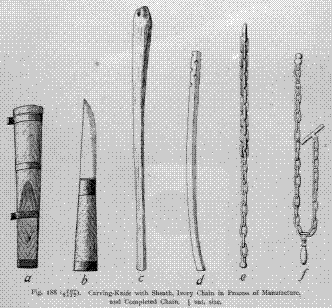
Fig. 188. Carving- Knife with Sheath, Ivory Chain in Process of Nanufacture, and Completed Chain. 1/4 nat. size.
found with monstrous forms; for instance, in my collection there is a little figure of a partridge with two heads. The Koryak from whom I obtained this carving could give me no satisfactory explanation of it; and I do not know whether it was the product of the individual fancy of the artist, or whether it represents some mythical bird. Among the carvings of the Eskimo of Point Barrow, reproduced in Murdoch's work, we also find figures of animal monsters, among which there is an ivory carving of a ten-legged bear and a double-headed animal carved from antler.2 Murdoch's illustration repre-
1 See Fig. 144, d, p. 621. 2 See Murdoch, Figs. 412, 414, 416, pp. 405-407.
85-JESUP NORTH PACIFIC EXPED., VOL. VI. PART 2.
672
JOCHELSON, THE KORYAK.
senting a giant holding a whale 1 recalls a Chukchee ivory carving in the collection of the Academy of Sciences at St. Petersburg, representing a human figure with three pairs of white whales on its breast.2 This figure corresponds with the Chukchee myth of a giant who once came from the American shores to the Chukchee coast, where he went to sleep, and remained asleep all winter, while the white whales came out on the shore and gnawed at his flesh.3
Engravings. — We have seen that the realistic animal carvings of the Koryak, like those of the Eskimo, are frequently ornamented by means of incised designs consisting of plain dots, rings, or lines; but we do not find any complex engravings of patterns or figures of pictographic character, such as are found on the carvings of the Alaskan Eskimo.
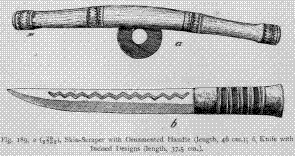
Fig. 189. a, Skin-Scraper with Ornamented Handle (length, 46 cm.); b, Knife with Incised Designs (length, 37.5 cm.).
In the collection of carvings in the Museum of the Imperial Academy of Sciences at St. Petersburg, there are two bone pipes with engravings of diminutive figures of men and animals. These pipes were acquired among the Kerek, but had their origin among the insular Eskimo of Bering Sea.4
The tools and implements of the Koryak are mostly devoid of all ornamental engravings. The few ornamental engravings which are found on the tools and other household articles may be divided into the following classes, — the simplest, or Eskimo-like; the pictographic, or engravings resembling those of the northern Indians of the interior and the Alaskan Eskimo; and the conventionalized, adopted from Asia. Figs. 189-191 represent specimens of the first group of ornamental engravings.
Fig. 189, a, represents an iron skin-scraper. Its wooden handle is orna-mented with lines and zigzags. It was obtained in Paren.5 Fig. 189, b,
1
Murdoch, Fig. 415, p. 406.
2
Bogoras,
Chukchee Material Life, Plate XX, Fig. 5.
3 Ibid., p.
57.
4 Ibid., Plate XXV, Figs. 8, 9.
5 A similar
ornamentation is
found on
the Eskimo bone
knife and
bone skin-dresser in Hoffman's book,
Plate XV, Fig. 3; and Plate XVIII, Fig. 2.
673
JOCHELSON, THE KORYAK.
represents a belt-knife of Koryak make. The blade is ornamented with a zigzag design. The wooden handle is entirely covered with brass, which is decorated by grooves and lines which enclose fields of hachure. We meet the zigzag ornamentation with acute or obtuse angles also in the ornamen- tation of garments (see, for instance, Figs. 209, 216).
Fig. 190 represents a woman's implement used in the ornamentation of funeral dress. It consists of a common handle made from walrus-tusk, with two flat chisel-edged awls of different widths which turn on pivots. When the smaller awl is required, the larger one is. turned aside,
| and the smaller one is given a vertical position as required in use, and vice versa. The ends of the awls are of iron, but in olden times they were of stone or bone. These tools are used in making slits at uniform intervals in seal-skins painted black.1 Through the slits thus made are passed narrow strips of leather cut from the skin of a dog's throat. This skin, when finished, is whiter and finer than the finest chamois-skin. In this way, in the middle of the black strip of seal-skin, an ornamental ribbon is formed, in which the black and the white narrow strips or squares succeed one another (see Fig. 197). These strips are used in trimming the coats and other parts of funeral dress. The parallel |
Fig. 100 Sliting- Tool. Length, 9 cm. |
lines engraved and etched lengthwise on the handle of the implement represent the strips of seal-skin, while the short parallel cross-lines represent the slits made by the awl. The line ornament on the implement may thus be called a textile ornament. The middle of the obverse of the handle, andthe whole reverse, are decorated with a herring-bone pattern, with the apex towards the cutting-end. On the reverse of the handle the lateral lines of the herring-bone pattern cover the whole surface. The haft of the wider awl has the ribbon-ornament shown in the illustration, and consisting of alter- nate squares on three sides; while the design on the reverse face consists of the two diagonals, the four triangles thus formed being filled in by two or three triangles the sides of which are parallel to the diagonals.
The reverse of the haft of the narrower awl is decorated with two intercrossing herring-bone designs covering the whole surface, — one with the apex towards the awl, the other with the apex towards the handle, — the middle line of the two being the same. The outer and inner sides of this handle are decorated with a peculiar irregular design, which apparently consists of a chain of rhombi, their obtuse angles adjoining, extending along the haft. In each rhombus an attempt seems to have been made to place another rhom- bus parallel to the outer one, while some of the intervening outer, triangles
1 This method of ornamentation will be described later on i.see p. 679).
674
JOCHELSON, THE KORYAK.
are filled in with smaller parallel triangles, and others remain undecorated. The implement was obtained by me in Kuel, The device shown in Fig. 191, a, is also made from walrus-tusk, and was obtained in the same place. It is used as a reel for winding embroidered and ornamented strips of skin or fur on its axle. These strips are used for trimming the edges of clothing. The axle and the two bone disks are decorated with dots, circles, and
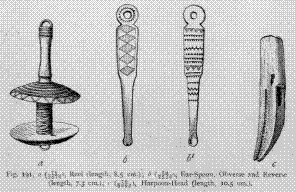
Fig. 191. a, Reel (length, 8.5 cm.); b, Ear-Spoon, Obverse and Reverse (length, 7.3 cm.); c, Harpoon-Head (length, 10.5 cm.).
chevrons. Fig. 191, b, represents a bone ear-spoon collected by Mr. Bogoras in northern Kamchatka. The handle of the spoon is ornamented by a row of rhombi running lengthwise, and touching each other at their angles, inside of which vertical lines are engraved. The rhomboidal ornamentation resem- bles the engravings on Tlingit neck-ornaments,1 which contain rhombi without etched lines inside. As we shall see further on, the Koryak women, in decorating their fur rugs, used rhombi to represent ice-floes (see Fig. 238). The reverse side is shown in Fig. 191, b'. Here may also be mentioned an engraved harpoon-head (Fig. 191, c).
Fig. 192 represents three snuff-boxes of birch-bark, made in Kamenskoye. hose shown in a and c can be closed with separate wooden covers; the handle of the cover in c represents a dog's head. The cover of b opens on a pivot made of tin tubes and wire. The engraved ornamentation is almost the same on all the snuff-boxes. It consists principally of dots, triangles, and concentric circles. The circles are somewhat similar to the circle-orna- ment attached to clothing (see Figs. 224 and 227). The cover on b is ornamented with the representation of a conventionalized plant, the veins being made of inlaid wire, while on c there is a row of double rhombi on the side.
1 See Hoffman, Plate IX, Fig. I.
675
JOCHELSON, THE KORYAK.
Figs. 193 and 194 represent specimens of engravings of a pictographic nature. Fig. 193 represents two women's knives.1 Outlines of running rein- deer are engraved on the blades by means of a steel awl. The outlines of the reindeer are somewhat inferior in vividness to the engravings of reindeer figures on ivory made by the Alaskan Eskimo; but allowance should be made for the material (iron) on which the Koryak artist engraved the reindeer. A middle line may be observed on the reindeer in b, which is absent in a, and consists of a series of minute vertical dashes. This line represents the spinal column. Fig. 194 represents two cutting-boards 2 used by women in dress-making. The boards contain ornamental engravings on the under side. The patterns for dresses
|
|
|
Fig. 192. Birch - Bark Boxes. Height, 6 cm., 7 cm., 14 cm. |
are cut on the unornamented side. The boards] are engraved by the men (the brothers or betrothed of the women to whom the boards belong), for amusement. The engravings consist of household and hunting-scenes; and
| the workmanship differs from that of most Eskimo engravings in that the figures of human beings and animals are not merely indicated by lines and by contours, but are cut out in- taglio. Moreover, some parts of the figures are frequently made somewhat more prominent than others, after the manner of bas- reliefs, which makes the figure |
|
|
Fig. 193. Knives with Incised Designs. Length, 26 cm., 29 cm. |
of the animal more vivid than ordinary engraved silhouettes.
Both specimens reproduced here were collected on the Palpal from Koryak living on the coast of Bering Sea: a was made on the Opuka River; b, on the Poqa'c River. In a is represented a scene from the life of fisher-
1 See p. 621. 2 See p. 627.
676
JOCHELSON, THE KORYAK.
men. The make-up is conventional, and there is lack of perspective. Thus on the left side we see a woman, who, in a kneeling position, is carving fish on the around in order to dry it in the sun; farther to the right, what seems to be the figure of a man, holding a disembowelled fish and the severed head of the fish in his hands, is running toward the drying-frames in order to hang them up for drying; still farther to the right, a man is trying
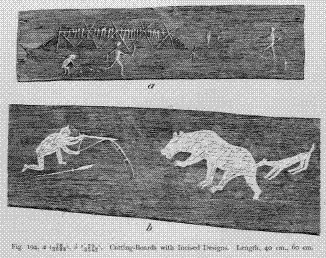
Fig. 194. a,b Cutting-Boards with Incised Designs. Length, 40 cm., 60 cm.
to catch a fish by means of a pole and hook. The boundary-line between the water and the shore does not appear. Evidently the river or the sea must be in the background, behind the man and the drying-frames. The lack of perspective does not appear so clearly in Fig. 194, b, for the reason that all the objects represented there are in one plane. It represents a hunter kneeling on one knee, with a flint gun, the butt of which is pressed against his shoulder, while the barrel rests on a wooden stand. He is aiming the gun at a bear, which is attacked in the rear by a dog. Although the figures are only silhouettes, the posture of the man and the motions of the animals are brought out with remarkable vividness. Moreover, the propor- tions between the different objects have been well observed. It is interesting to note here, that the specimen shown in Fig. 194, b, was made by a Rein- deer Koryak of Poqa'c, a young man of twenty-five years, whom I have seen on the Palpal. This proves that among the Reindeer Koryak we also find men with a high artistic taste.
677
JOCHELSON, THE KORYAK.
Along the shores of Penshina Bay the ornamentations on cutting-boards frequently consist of figures of steamers or schooners which land from time to time at the settlement. These engravings resemble in every respect those of the Eskimo in their manner of representing schooners and steamers.1
Figs. 195 and 196 represent forms of engravings of foreign origin adopted from the Tungus and other neighbors. Fig. 195, a-c, represents
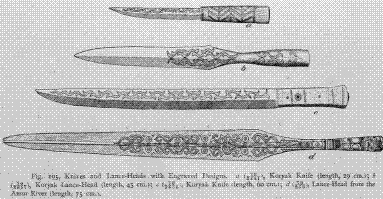
Fig. 195. Knives and Lance-Heads with Engraved Designs. a, Koryak Knife (length, 29 cm.); b, Koryak Lance-Head (length, 45 cm.); c, Koryak Knife (length, 60 cm.); d Lance- Head from the Amur River (length, 75 cm).
specimens of workmanship of Koryak blacksmiths,2 with ornaments engraved and with inlaid copper and brass. The art of the blacksmith being of recent origin among the Koryak, their decorations on articles of iron are adopted from other tribes. In my opinion, the ornamentations of the belt-knife (a), of the "large knife" (c),3 and of the spear (b), shown in Fig. 195, came down to the Koryak from the Amur natives through the medium of the Tungus; and the Amur people, in their turn, adopted them from the Chinese. This ornamentation appears as a simplified conventionalization of the simple and combined cocks, which we see in the Amur spear (Fig. 195, d).4 The orna- mentation of the wooden handle of the knife a, which is inlaid with tin, is evidently adopted from the Yakut, among whom such knife-handles are often found; and the ornamentation represents, as I was told, in a conventional way, the larch-tree. The short handle of the large knife c is made of bone of whale.
The interior part of the ornament of the cutting-board (Fig. 196, a) is also of the Amur type. The middle of this board serves for winding embroi-
1 See Boas, The Central Eskimo,
Plate V. Fig. f, Hoffman, Figs
29-31, p. 797. Samples
of Koryak cutting-boards
with figures of steamers are in the Koryak collection
of the American Museum of Natural History in New York.
2 See p. 611.
3 See pp. 561, 620.
4 See Laufer, The Decorative Art of the Amur Tribes.
678
JOCHELSON, THE KORYAK.
dered trimmings used for dresses, fur strips for coat-trimming, and other strips for dress-ornamentation. The combination of curved lines in this orna- mental engraving is not of Koryak origin; but, instead of the spiral ornament of the Amur tribes, we have here a series of arches, the ends of which meet on one side. The rings with stars on the snuff-box (c), were adapted by the artist from a drawing on Russian printed calico. I shall speak more fully of such adaptations further on. It will suffice here to call attention to
technical style of ornamentation, representing nettings, for instance; animal ornamentation, consisting of a realistic representation of individual animals and human beings, or of groups of them, of a pictographic nature; and, finally, there is the conventionalized plant-ornament. The last kind of ornamentation I consider the latest acquisition adopted from the Russians.
While the carvings and engravings are the art of man, the ornamenta-tion of clothing and rugs is the result of the artistic efforts of woman. The simplest dress-decoration consists1 in the binding of skin dresses with fur, or in the trimming of fur clothing with fur of a better kind than that of the clothing, or of a different color, and in the use of white, black, and red dyed skin, either with the hair removed or placed flesh side outward, the hair which is on the inside of the coat being shorn.
679
JOCHELSON, THE KORYAK.
Technique of Ornamentation. — The designs on garments are through-out arranged in horizontal or vertical strips, as may be seen in Figs. 216, 217, 225, 227. These strips consist of a series of parallel stripes, each showing a particular design. In all Koryak ornamentation of clothing, these strips are made separately. In making them, they are wound on reels like those illustrated in Figs. 191, a, and 196, a, b. After the strips have been finished, they are. sewed together.
The methods of decorating these strips are quite varied. A great many designs are made by a method which may be called "slit-embroidery." This
| method - is applied particularly for making designs consisting of narrow white lines on a black back- ground, the black background being thick black skin, — chiefly the skin of a ringed-seal dressed and dyed black, — and the white being produced by means of prepared thin white skin of the dog's throat and of sinew-thread. A series of narrow slits are |
|
|
Fig. 197. Technique of Slit- Embroidery |
made in the black skin which is to be decorated (Fig. 197). A strip of white dog-skin of the same width as the slits is laid under the line of slits
| and a small loop of this skin is pushed from underneath up through the slits, where it is caught by a sinew thread, which lies on the surface of the skin, and is passed through the loops, which are then drawn tight. In some cases, instead of laying the dog-skin under the black skin, the slits are not cut through, but are connected by splitting the skin from one slit to the next slit. In this case the dog-skin is passed right along between the outer and inner layer of the black skin. It is caught in the same way as described before. The principaltypes of designs made in slit-em- broidery are shown in Fig. 198. The technique of the slit-em- broidery is such that the designs necessarily consist of long con nected series of rectangular figures; the white skin which is pulled through the slits forming a series of short parallel lines the ends of which are |
|
86—JESUP NORTH PACIFIC EXPED., VOL. VI PART 2.
680
JOCHELSON, THE KORYAK.
connected by the white sinew thread. The width of the rectangles varies considerably, since often a series of slits forming one straight line are con nected by a single thread (Fig. 198). Sometimes also, instead of rec- tangles, the designs consist rather of an angular meander, a single thread being pulled through the skin loop in one direction, then across to the next loop, and back in the other direction. Some of the finest of these slits are not more than 1 mm. in width, while the rows of slits are sometimes as near together as .25 mm. Coarse slits of this kind are as wide as 2 mm., and the rows are about 1 mm. apart.
The designs consist, on the whole, of groups of rectangles, either held together by chains or separately arranged in rhythmic groups. Other designs consist of triangles rising over a wave-line or over a connected line, or entirely isolated.
In making up rows of designs in this technique, all the slit-embroidery gives thin white lines on a black background. Although the dog-skin, when
|
|
seen near by, is a little more yellow than the white sinew, this difference disappears by contrast with the dark back- ground. The same method is sometimes used for making red fringes at the borders of garments. In this case the lowest border consists of a |
| Fig. 199. a, Tassels done in Slit-Embroidery; b, Caught-in Strips. |
strip of bare white skin. Dog-skin is pulled through the slits as described before, and in these slits tassels of red yarn or of the hair of young seal dyed red are caught. Sometimes there are double slits, so that the tassel is caught as shown in Fig. 199, a.
In some cases single white cross-strips on a narrow black background are made by winding a narrow strip of white skin once around the black strip, which is then sewed to the preceding strip in such a way that the ends of the white winding are just in the seam, where they are held in place.
Whenever wider white lines on a black background are desired, another technique is applied. This consists in the application of short narrow strips of stiff white reindeer-skin, — more rarely of white dog-skin, — which are caught in the seam between two adjoining strips of dark skin (Fig. 199, b), the whole seam being overlaid with sinew or hair (see p. 681). When a narrow strip of squares is to be formed in this way, the lower ends of these strips are caught in the same way in the next seam below. This same method is applied in making the fringe along the lower border of garments (see Figs. 207 and 212). In this case, strips of such skin alternate with tassels of the hair of young seal dyed red, both being caught in the seam, which,
68I
JOCHELSON, THE KORYAK.
however, is not overlaid with sinew. The hair of the tassel is doubled over and the small strip of skin placed in the bend, and the two are caught in this way, generally by three stitches. The hair which lies under the skin makes in this way a somewhat raised seam. The same method is used for emphasizing the stitches of a white seam. In this case very short pieces of stiff, white skin are caught in the manner described before, and are cut off close to the overlaid sinew.
When narrow black strips or small black squares on a white background are desired, still another method is used. A narrow strip of black skin about 3 mm. in width is wrapped with white dog-skin about I mm. wide. In the middle of the outer side a longitudinal narrow strip of white dog- skin is applied under the winding. This method is used, for instance, in the garment.
For overlaying seams and for making curved or diagonal designs on black bare skin, a method which we might call "sinew or hair applique" is used. The sinew or hair is laid on in the desired form, and is stitched over with finer sinew, the stitches passing through the upper layer of the skin, and not appearing on the under side.1 For overlaying, hair from the mane of the elk and reindeer, and hair of the mountain-sheep, are used. This method is the same as the one used in sewing coiled grass baskets (see p. 632).
A succession of disconnected white squares on a black background is made in the same style of embroidery by weaving in white dog-skin, which passes through a series of slits
When ever red fur is desired as an inset in these designs, it is made by applying tassels of dyed hair of young seals to reindeer-skin, the flesh side of which is dyed red and turned outward. These tassels are arranged close together in horizontal rows, each tuft of hair being turned over in the middle and being held by a stitch which passes only through the outer layer of the skin (see Fig. 199, a). Other patterns, such as checker-work and realistic figures, are almost always made of skin mosaic, each strip being finished by itself, and being sewed to the preceding strip. All the sewing is done on the right side; and wherever the seam is not covered by other ornamentation, it is overlaid with sinew or hair. Mosaics in which compli-cated forms are set in are made from patterns cut from the thick skin of the thong-seal, which is used for cutting out the various figures, say of white skin, with or without hair. The same pattern is used to cut out the figure from the black background. The white figure is then inserted in the opening thus made. In this way black and white silhouettes of animals or other figures are obtained on a white or a black background. The convention- alized plants and geometric figures are more difficult to cut out and sew in
1 The same type of overlaid seams is found in Norton Sound, Alaska.
682
JOCHELSON, THE KORYAK.
than animals. Frequently the designs are made up of such small pieces, that it is surprising how such tedious work can be done at all. Not every woman can cut out figures. There are specialists among them who supply these figures.
On some coats made of skin without hair, designs are also formed by small tufts of hair of young seal dyed red, which are sewed on in rows or in straight lines and zigzags, the tufts appearing like red spots on the white background of the coat. Such tufts are also used to make triangular forms on white or black backgrounds by being sewed in as described before (see Fig. 210).
Long narrow strips of skin, almost like fringe, appear sometimes in the long strips of embroidery along the lower border of coats (see Fig. 210). These are generally caught in the same way as the fringe at the bottom of the coat, which was described before, each strip of skin being caught sepa- rately. In the coat here referred to, they consist of long narrow strips of bare white skin decorated with equidistant black cross-lines.
Tassels consisting of bare skin are made of long pieces of skin slit up into from five to eight narrow strips, which are sewed on flat to the back or front of the coat. Generally these are arranged in rows, the strips being sewed on in pairs or in groups of three, four, or five. Sometimes tassels are made of threads of reindeer or elk 1 sinew, white or dyed red. Some- times tufts of hair of young seal dyed red are tied for quite a distance down the base of the tassel, thus producing the effect of fur tassels with string ends. A more complex fur tassel is made up of small pieces of white and dark reindeer-fur, the ends of each piece being sewed together so that it forms a bell-shaped bead, which is wider open at one end than at the other. These are strung on a strip of skin, to which they are attached so that they cannot slip off. In many cases the upper part of these fur-bead tassels con- sists of a single strip which divides farther down. In one coat the fur beads are so small, and trimmed down so regularly, that they almost appear like bone beads. In some cases glass beads are strung on with the fur tassels.
On some of the dyed dancing-garments the ornamentation consists prinipally of white skin applique on the red background of the garment. The principal designs that occur in this form are rows of triangles. The same kind of triangles occur commonly on the fur coats with embroidered borders.2 Other designs in appliqué-work are shown in Fig. 200. For designs in appli- que see also the woman's coat shown in Fig. 116, p. 589.
1 It should be noted that the Koryak obtain elk sinew or hair
for ornamentation from the Chukchee, Tungus,
or Yukaghir, as there are no elks in their own territory.
2
Similar patterns
occur in the
decoration of Greenland garments. They are made in appliqué-work, which,
However, is never caught in the seams, nor
woven. It is simply
sewed on.
683
JOCHELSON, THE KORYAK.
Still another method of skin ornamentation consists in stamping designs in red color on bare skin. A series of wooden stamps used for this purpose are shown in Fig. 201. A coat decorated by means of these stamps is shown in Fig. 218.
Embroidery in silk and yarn is made by long flat stitches, which, how-ever, do not pass through the skin, but only under the upper layer. The
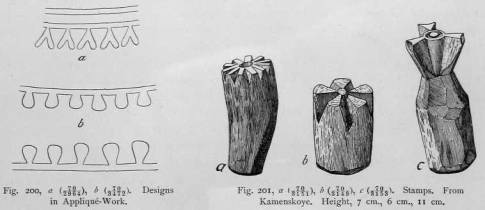
Fig.
200. Designs in Applique- Work. Fig. 201. Stamps.
From Kamenskoye. Height, 7 cm., 6 cm., 11 cm.
patterns are laid out in the following way: Looking at the design which serves as a sample, the woman marks on the skin with the end of a bone knife the necessary curves, circles, etc., and then covers these marks with embroidery. The Alutor Koryak women are especially fond of bead- embroideries.
Fig. 202 represents a belt embroidered with beads (a), and a pouch (b) for flint and touch-wood, which is sewed to a plain leather belt. The line- rnament of belt a is embroidered in three colors, — blue, black, and white; while the ornament with human figures on the pouch is made of beads of two colors, — white and blue. The belt (a) is represented here without buckle and strap.